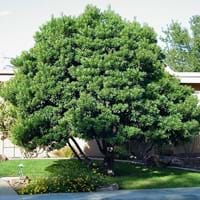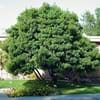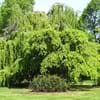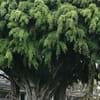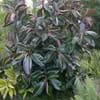Life Span
Perennial
Perennial
Type
Tree
Bulb or Corm or Tuber
Origin
China, Japan
Hybrid origin
Types
it is a type of blueberry
Not Available
Habitat
Not Applicable
tropical environments
USDA Hardiness Zone
9-11
8-11
AHS Heat Zone
11-5
Not Available
Sunset Zone
H1, 8, 9, 14, 15, 16, 17, 18, 19, 20, 21, 22, 23, 24
21,22
Habit
Upright/Erect
Clump-Forming
Flower Color
White
White, Red, Light Pink
Flower Color Modifier
Bicolor
Bicolor
Fruit Color
Dark Blue, Black
Green, Brown
Leaf Color in Spring
Green, Dark Green, Bronze, Orange Red
Green, Dark Green
Leaf Color in Summer
Dark Green
Light Green
Leaf Color in Fall
Dark Green
Several shades of Green
Leaf Color in Winter
Red, Dark Green
Light Green
Leaf Shape
Crescent-shaped
Long Linear
Plant Season
Spring, Summer, Fall
Spring, Summer, Winter
Sunlight
Full Sun, Partial Sun
Full Sun, Partial Sun
Type of Soil
Loam, Sand
Loam, Sand
The pH of Soil
Acidic, Neutral
Acidic, Neutral
Soil Drainage
Average
Well drained
Bloom Time
Late Spring, Early Summer
Not Available
Tolerances
Not Available
Deer resistant
Where to Plant?
Ground
Container, Ground, Pot
How to Plant?
Rooted stem cutting, Seedlings
Divison, From Rhizomes, Tubers
Plant Maintenance
Low
Low
Watering Requirements
Requires watering in the growing season, Water when soil is dry
Average Water Needs
In Summer
Lots of watering
Lots of watering
In Spring
Moderate
Moderate
In Winter
Ample Water
Average Water
Soil pH
Acidic, Neutral
Acidic, Neutral
Soil Type
Loam, Sand
Loam, Sand
Soil Drainage Capacity
Average
Well drained
Sun Exposure
Full Sun, Partial Sun
Full Sun, Partial Sun
Pruning
Prune in winter, Prune when young, Remove branches, Remove short twigs
Cut or pinch the stems, Remove damaged leaves, Remove dead branches, Remove dead leaves
Fertilizers
All-Purpose Liquid Fertilizer, Fertilize in early spring, Mulch
as it is a flowering plant, use high phosphorous content fertilizer, Nitrogen, Phosphorous, Potassium, Requires high amount of nitrogen
Pests and Diseases
Black Silt, Leaf rust, Sooty Mold
Aphids, Grasshoppers, Mealybugs, Mites, Red blotch, Slugs, Snails
Plant Tolerance
Not Available
Deer resistant
Flower Petal Number
Single
Not Available
Edible Fruit
No
Not Available
Fragrant Flower
Yes
Not Available
Foliage Texture
Medium
Medium
Foliage Sheen
Glossy
Glossy
Attracts
Birds
Bees, Butterflies, Hummingbirds
Allergy
Not Available
poisonous if ingested
Aesthetic Uses
Bonsai, Showy Purposes
Beautification, Bouquets, Cottage Garden, Showy Purposes
Beauty Benefits
For treating wrinkles, Skin Problems
Not Available
Environmental Uses
Air purification, Shadow Tree
Not Available
Medicinal Uses
Bone strength, Cancer, Diabetes, Digestion problems, Heart problems, High blood pressure, Improving mental health, Vitamin C, Weight loss
Not Available
Part of Plant Used
Fruits
Flowers
Other Uses
Edible syrup, Employed in herbal medicine, Used As Food, Used as Ornamental plant
Used as Ornamental plant, Used for bedding in gardens
Used As Indoor Plant
No
Yes
Used As Outdoor Plant
Yes
Yes
Garden Design
Hedges, Screening / Wind Break, Shade Trees, Street Trees
Container, Cutflower, Houseplant, Mixed Border, Tropical
Botanical Name
ELAEOCARPUS decipiens
HIPPEASTRUM 'Picotee'
Common Name
Japanese Blueberry
Florist Amaryllis, Hippeastrum, Picotee Hippeastrum
In Hindi
जापानी ब्लूबेरी
HIPPEASTRUM
In German
japanische Blaubeere
HIPPEASTRUM
In French
bleuet japonais
HIPPEASTRUM
In Spanish
arándanos japonés
Hippeastrum
In Greek
ιαπωνική βατόμουρου
Hippeastrum
In Portuguese
blueberry japonês
HIPPEASTRUM
In Polish
Japoński borówki
Hippeastrum
In Latin
Vaccinium Italica
Hippeastrum
Phylum
Not Available
Magnoliophyta
Class
Not Available
Magnoliopsida
Order
Oxalidales
Asparagales
Family
Elaeocarpaceae
Amaryllidaceae
Genus
Elaeocarpus
Amaryllis
Clade
Angiosperms, Eudicots, Rosids
Angiosperms, Monocots
Tribe
Not Available
Not Available
Subfamily
Not Available
Amaryllidoideae
Season and Care of Japanese Blueberry and Hippeastrum
Season and care of Japanese Blueberry and Hippeastrum is important to know. While considering everything about Japanese Blueberry and Hippeastrum Care, growing season is an essential factor. Japanese Blueberry season is Spring, Summer and Fall and Hippeastrum season is Spring, Summer and Fall. The type of soil for Japanese Blueberry is Loam, Sand and for Hippeastrum is Loam, Sand while the PH of soil for Japanese Blueberry is Acidic, Neutral and for Hippeastrum is Acidic, Neutral.
Japanese Blueberry and Hippeastrum Physical Information
Japanese Blueberry and Hippeastrum physical information is very important for comparison. Japanese Blueberry height is 910.00 cm and width 610.00 cm whereas Hippeastrum height is 38.10 cm and width 30.10 cm. The color specification of Japanese Blueberry and Hippeastrum are as follows:
Japanese Blueberry flower color: White
Japanese Blueberry leaf color: Green, Dark Green, Bronze and Orange Red
Hippeastrum flower color: White, Red and Light Pink
- Hippeastrum leaf color: Green and Dark Green
Care of Japanese Blueberry and Hippeastrum
Care of Japanese Blueberry and Hippeastrum include pruning, fertilizers, watering etc. Japanese Blueberry pruning is done Prune in winter, Prune when young, Remove branches and Remove short twigs and Hippeastrum pruning is done Cut or pinch the stems, Remove damaged leaves, Remove dead branches and Remove dead leaves. In summer Japanese Blueberry needs Lots of watering and in winter, it needs Ample Water. Whereas, in summer Hippeastrum needs Lots of watering and in winter, it needs Average Water.
